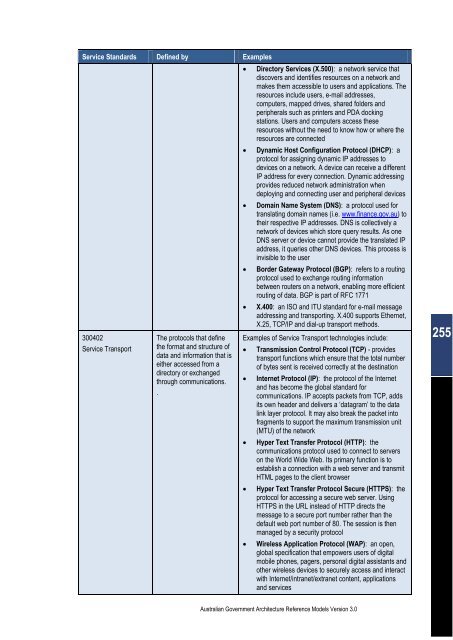Australian Government Architecture Reference Models Version 3.0
Australian Government Architecture Reference Models Version 3.0
Australian Government Architecture Reference Models Version 3.0
Create successful ePaper yourself
Turn your PDF publications into a flip-book with our unique Google optimized e-Paper software.
Service Standards Defined by Examples<br />
300402<br />
Service Transport<br />
The protocols that define<br />
the format and structure of<br />
data and information that is<br />
either accessed from a<br />
directory or exchanged<br />
through communications.<br />
.<br />
� Directory Services (X.500): a network service that<br />
discovers and identifies resources on a network and<br />
makes them accessible to users and applications. The<br />
resources include users, e-mail addresses,<br />
computers, mapped drives, shared folders and<br />
peripherals such as printers and PDA docking<br />
stations. Users and computers access these<br />
resources without the need to know how or where the<br />
resources are connected<br />
� Dynamic Host Configuration Protocol (DHCP): a<br />
protocol for assigning dynamic IP addresses to<br />
devices on a network. A device can receive a different<br />
IP address for every connection. Dynamic addressing<br />
provides reduced network administration when<br />
deploying and connecting user and peripheral devices<br />
� Domain Name System (DNS): a protocol used for<br />
translating domain names (i.e. www.finance.gov.au) to<br />
their respective IP addresses. DNS is collectively a<br />
network of devices which store query results. As one<br />
DNS server or device cannot provide the translated IP<br />
address, it queries other DNS devices. This process is<br />
invisible to the user<br />
� Border Gateway Protocol (BGP): refers to a routing<br />
protocol used to exchange routing information<br />
between routers on a network, enabling more efficient<br />
routing of data. BGP is part of RFC 1771<br />
� X.400: an ISO and ITU standard for e-mail message<br />
addressing and transporting. X.400 supports Ethernet,<br />
X.25, TCP/IP and dial-up transport methods.<br />
Examples of Service Transport technologies include:<br />
� Transmission Control Protocol (TCP) - provides<br />
transport functions which ensure that the total number<br />
of bytes sent is received correctly at the destination<br />
� Internet Protocol (IP): the protocol of the Internet<br />
and has become the global standard for<br />
communications. IP accepts packets from TCP, adds<br />
its own header and delivers a ‘datagram’ to the data<br />
link layer protocol. It may also break the packet into<br />
fragments to support the maximum transmission unit<br />
(MTU) of the network<br />
� Hyper Text Transfer Protocol (HTTP): the<br />
communications protocol used to connect to servers<br />
on the World Wide Web. Its primary function is to<br />
establish a connection with a web server and transmit<br />
HTML pages to the client browser<br />
� Hyper Text Transfer Protocol Secure (HTTPS): the<br />
protocol for accessing a secure web server. Using<br />
HTTPS in the URL instead of HTTP directs the<br />
message to a secure port number rather than the<br />
default web port number of 80. The session is then<br />
managed by a security protocol<br />
� Wireless Application Protocol (WAP): an open,<br />
global specification that empowers users of digital<br />
mobile phones, pagers, personal digital assistants and<br />
other wireless devices to securely access and interact<br />
with Internet/intranet/extranet content, applications<br />
and services<br />
<strong>Australian</strong> <strong>Government</strong> <strong>Architecture</strong> <strong>Reference</strong> <strong>Models</strong> <strong>Version</strong> <strong>3.0</strong><br />
255

















